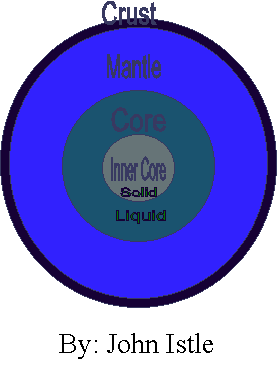What are Seismic Waves?
Seismic Waves are the waves of energy that are caused by the sudden movement of rocks or explosions within the earth. The energy of these waves travels through the earth. Imagine if you will, a stone being thrown into the middle of the lake. Out from the entry point of the stone, into the lake come ripples. In comparison, the stone being thrown into the lake is like an explosion or movement within the earth. The ripples in the lake would then be like seismic wave that travels through the earth. Of course seismic waves and earthquakes are far more complicated than a stone being thrown into water and ripples flowing through. A seismic wave has many components within its waves and it travels differently through many parts of the earth.
Components of a Seismic Wave
There are many different types of seismic waves, but all of these seismic waves are there are basically two types.
Body Waves:
Compressional of P waves (P for primary)
Traverse or S waves (S for secondary or shear)Surface Waves
Love waves
Reyleigh waves
Body Waves travel through the earth's inner layers

Body waves have two components P waves and S waves. When an earthquake happens, it radiates P waves and S waves in all directions, much like a stone emits ripples throughout the lake. The first of these waves to be detected is the P wave.
Surface wave on the other hand can only travel along the Earth's surface and their amplitude decreases with depth into Earth. Surface wave components are Love waves and Reyleigh waves.

Properties of Seismic Waves
Seismic waves generally travel fast. Just as a car can be thought of as traveling in kilometers per hour (km/h), a seismic wave can be thought of as traveling in kilometers per second (km/s). But the exact speed of how fast a seismic wave may travel has many factors. Among them is the material the seismic wave has to travel through. Another is the temperature and pressure of the environment in which the wave is traveling in. Generally waves travel faster in lower temperature and higher pressure. Also different types of seismic waves travel at different speeds.
(maybey insert picture of car vs wave speed)
Properties of Compressional or P waves
The first kind of body wave is the P wave. This is the fastest kind of seismic wave their name derives for the fact that P is an abbreviation for primary, first wave to arrive. The P wave generally travel at speeds between 1 and 14 km/sec. The P wave can move through solid rock and fluids, like water or the liquid layers of the earth. It pushes and pulls the rock it moves through just like sound waves push and pull the air. Sometimes animals can hear the P waves of an earthquake. Usually we only feel the bump and rattle of these waves
Properties of Traverse or S waves
The second kind of body wave is the Shear or Secondary wave. Secondary or shear waves travel slower than P waves. Even though they are slower, S waves still move quickly, at about 1 to 8 km/s. The lower bound of this speed usually occurs around unconsolidated material while the upper bound of this speed usually occurs at the earth's mantel. S waves do not have the ability to travel through a fluid or a gas environment. This is because s waves do not change the volume of the material they travel through they shear it. Gas and fluid environment cannot transmit a shear stress.
Properties of Love Waves
The first kind of surface wave is called a Love wave, named after A.E.H. Love, a British mathematician who worked out the mathematical model for this kind of wave in 1911. It's the fastest surface wave and moves the ground from side-to-side. Love waves are transverse waves that vibrate the ground in the horizontal direction perpendicular. These waves are formed by the interaction of S waves with the Earth's surface. The velocities at which a Love wave can travel are between 2 and 6 km/sec.
(insert animation of love wave)
Properties of Rayleigh Waves
The other kind of surface wave is the Rayleigh wave, named for John William Strutt, Lord Rayleigh, who mathematically predicted the existence of this kind of wave in 1885. A Rayleigh wave rolls along the ground just like a wave roll across a lake or an ocean right before they "break" at the surf line. Because it rolls, it moves the ground up and down, and side-to-side in the same direction that the wave is moving. Most of the shaking felt from an earthquake is due to the Rayleigh wave, which can be much larger than the other waves. Rayleigh waves are the slowest of all seismic wave types. Typically Reyleigh wave speeds are around 1 to 5 km/s.
Seismic information provided by: Leonel Acoba